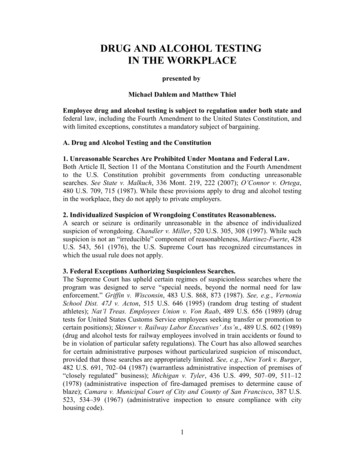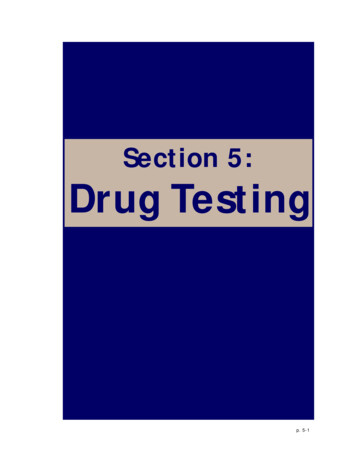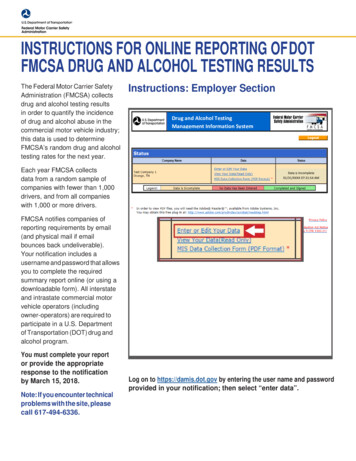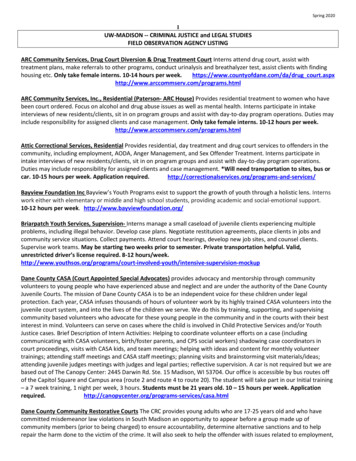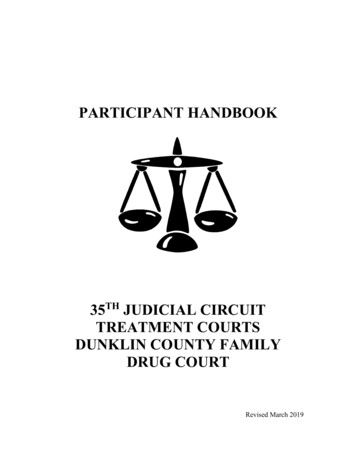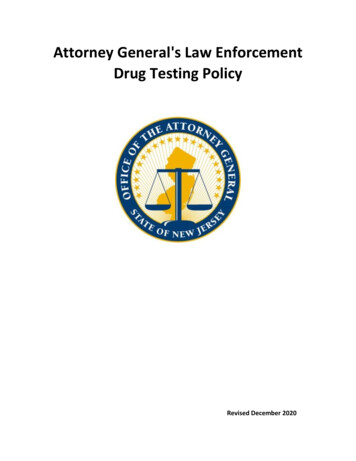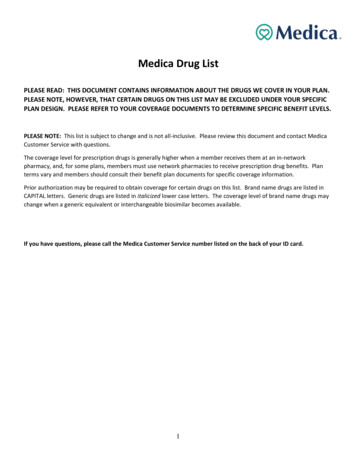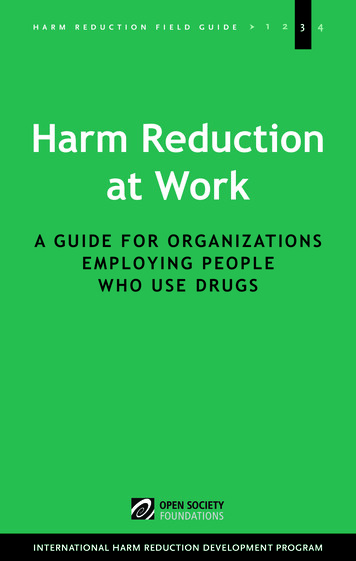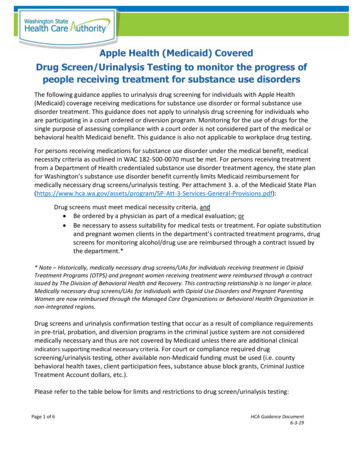
Transcription
Apple Health (Medicaid) CoveredDrug Screen/Urinalysis Testing to monitor the progress ofpeople receiving treatment for substance use disordersThe following guidance applies to urinalysis drug screening for individuals with Apple Health(Medicaid) coverage receiving medications for substance use disorder or formal substance usedisorder treatment. This guidance does not apply to urinalysis drug screening for individuals whoare participating in a court ordered or diversion program. Monitoring for the use of drugs for thesingle purpose of assessing compliance with a court order is not considered part of the medical orbehavioral health Medicaid benefit. This guidance is also not applicable to workplace drug testing.For persons receiving medications for substance use disorder under the medical benefit, medicalnecessity criteria as outlined in WAC 182-500-0070 must be met. For persons receiving treatmentfrom a Department of Health credentialed substance use disorder treatment agency, the state planfor Washington’s substance use disorder benefit currently limits Medicaid reimbursement formedically necessary drug screens/urinalysis testing. Per attachment 3. a. of the Medicaid State 3-Services-General-Provisions.pdf):Drug screens must meet medical necessity criteria, and Be ordered by a physician as part of a medical evaluation; or Be necessary to assess suitability for medical tests or treatment. For opiate substitutionand pregnant women clients in the department’s contracted treatment programs, drugscreens for monitoring alcohol/drug use are reimbursed through a contract issued bythe department.** Note – Historically, medically necessary drug screens/UAs for individuals receiving treatment in OpioidTreatment Programs (OTPS) and pregnant women receiving treatment were reimbursed through a contractissued by The Division of Behavioral Health and Recovery. This contracting relationship is no longer in place.Medically necessary drug screens/UAs for individuals with Opioid Use Disorders and Pregnant ParentingWomen are now reimbursed through the Managed Care Organizations or Behavioral Health Organization innon-integrated regions.Drug screens and urinalysis confirmation testing that occur as a result of compliance requirementsin pre-trial, probation, and diversion programs in the criminal justice system are not consideredmedically necessary and thus are not covered by Medicaid unless there are additional clinicalindicators supporting medical necessary criteria. For court or compliance required drugscreening/urinalysis testing, other available non-Medicaid funding must be used (i.e. countybehavioral health taxes, client participation fees, substance abuse block grants, Criminal JusticeTreatment Account dollars, etc.).Please refer to the table below for limits and restrictions to drug screen/urinalysis testing:Page 1 of 6HCA Guidance Document6-3-19
Health clinics or behavioral health treatment agencies prescribing medication for opioid and othersubstance use disorders and Opioid Treatment Programs (OTP) Programs*:Test typeNon-pregnantImmunoassay (80305, 80306, 80307)Presumptive, point ofUp to 24 per 12care, urine drug tests formonthsdrugs of abusePregnantUp to 18 duringpregnancyConfirmatory urine drug test by GCMS or LCMS (G0480, G0481)1-15 drug classesUp to 16 per 12Up to 12 duringmonthspregnancy16-21 drug classesNot coveredNot covered 21 drug classesNot coveredNot coveredEthyl glucuronideNot coveredNot coveredSerial quantitative druglevel testingQuantitativenorbuprenorphine tobuprenorphine levelsTHC/creatinine ratiosNot coveredNot coveredNot coveredNot coveredNot coveredNot coveredSubstance Use Disorder Treatment Agencies that do not prescribe medications for SUD*SettingFrequencyTest typeWithdrawal management(Detoxification) ProgramsOne at admissionImmunoassay(80305, 80306, 80307)Residential (Inpatient)TreatmentIntensive outpatienttreatment programsOutpatient treatmentprogramsOne per monthImmunoassay(80305, 80306, 80307)Immunoassay(80305, 80306, 80307)Immunoassay(80305, 80306, 80307)Four the 1st monththen 2 per month2 per monthLimitation extensionrequestsA confirmatory or morefrequent immunoassaytesting, (presumptive)may be requested witha limitation extension.Approval will be basedon medical necessityand clinicaldocumentation.*Drug screens ordered in a credentialed treatment agency must: be ordered by a prescribing provider, or benecessary to assess suitability for medical tests or treatment. Clinical documentation must meet and supportmedical necessity criteria.Page 2 of 6HCA Guidance Document6-3-19
Additional Considerations:These limits do not apply to persons who are enrolled in a therapeutic court and ordered to participatein chemical dependency treatment. Tests for these individuals are ordered by and are paid for by thecriminal court system. This guidance is also not meant to cover workplace drug testing.The rationale for not covering the tests listed above or covering them more frequently than outlined isas follows:It is expected that the frequency and utilization of both point of care and confirmatory tests willbe higher in the initial stages of treatment and taper off over time. Given statewide prescriptionmonitoring program reports and seizure information, there is not support for immunoassay ormass spectrometry testing more than 15 individual drug classes at any one time.Ethyl glucuronide levels when high are reflective of recent alcohol use, low cut off levels may befalsely negative for lower levels of alcohol use. There are also a number of substances that canlead to false positive ethyl glucuronide tests. This limits the ability to consistently draw reliableand accurate conclusions from the results to be applied towards patient care. If persistentevidence of alcohol use exists despite the person being treated for an alcohol use disorder, anincrease in treatment intensity should be considered.Because hydration status, diurnal variability, a person’s metabolic rate, and time since lastingestion can all effect drug levels and those of their metabolites, quantitative testing is notreliably predictive in reflecting patterns of use.Similarly there is not an agreed upon threshold, validated across large sample sizes or diversepopulations, for what an appropriate norbuprenorphine to buprenorphine ratio should be torule out diversion. The Medicaid program is by law required to use medical necessity to guidecoverage decisions. Testing for the presence or absence of a drug or its metabolite to assurecompliance with a therapeutic intervention may at times be considered medically necessary.Testing drug levels to determine whether or not ‘diversion’ or urine adulteration is occurringare not medical interventions and are not considered medically necessary.It is recognized that people often experience multiple concurrent substance use disorders.Urine drug testing is reflective of a moment in time and by itself is not diagnostic of a substanceuse disorder. If during treatment, urine drug testing suggests continued use and the individual’sfunctional status is not improving, a higher level of care or the delivery of higher intensityservices may be necessary.Confirmatory tests done in response to a negative presumptive screen require documentationof clinical signs or symptoms suggesting active use to document medical necessity.Page 3 of 6HCA Guidance Document6-3-19
Confirmatory tests done to confirm an individual’s self-reported use require chartdocumentation in support of medical necessity. Follow up visits must document theintervention that occurred as a result of a confirmatory test.References:Dupouy J, Mémier V, Catala H, et.al. Does urine drug abuse screening help for managing patients? Asystematic review. Drug and Alcohol Dependence. 2014; 136: 11–20.Substance Abuse and Mental Health Services Administration. Clinical Drug Testing in Primary Care.Technical Assistance Publication (TAP) 32. HHS Publication No. (SMA) 12-4668. Rockville, MD:Substance Abuse and Mental Health Services Administration, 2012.Moeller KE, Kissack JC, Atayee, RS et.al. Clinical Interpretation of Urine Drug Tests: WhatClinicians Need to Know About Urine Drug Screens. Mayo Clin Proc. 2017; 92(5): 774-796McDonell MG, Jordan Skalisky J, Leickly E, et.al. Using Ethyl Glucuronide in Urine to Detect Light andHeavy Drinking in Alcohol Dependent Outpatients Drug Alcohol Depend. 2015 December 1; 157: 184–187.Suzuki J, Zinser J, Issa M et.al. Quantitative testing of buprenorphine and norbuprenorphine to identifyurine sample spiking during office-based opioid treatment. Substance Abuse, 2017; 38:4, 504-507.Page 4 of 6HCA Guidance Document6-3-19
Payment Source for Urine Drug ScreensClient receiving treatment for a substance usedisorder and a urine drug screen is performedMedicaid Coverage: YesMedicaid Coverage: YesMedicaid Coverage: NoDiversion/Justice Involved: NoDiversion/Justice Involved: YesDiversion/Justice Involved: YesMedicaid pays if medical necessity anddocumentation criteria metMedicaid pays if medical necessity anddocumentation criteria metPage 5 of 6If ordered to monitor compliance with acourt order, non-Medicaid or otherfund source used for paymentIf ordered to monitor compliance witha court order, non-Medicaid or othernon-Medicaid fund source used forpaymentDoes not need to meet Medicaidmedical necessity criteriaHCA Guidance Document6-3-19
Urine drug testing is reflective of a moment in time and by itself is not diagnostic of a substance use disorder. If during treatment, urine drug testing suggests continued use and the individual's functional status is not improving, a higher level of care or the delivery of higher intensity services may be necessary.

